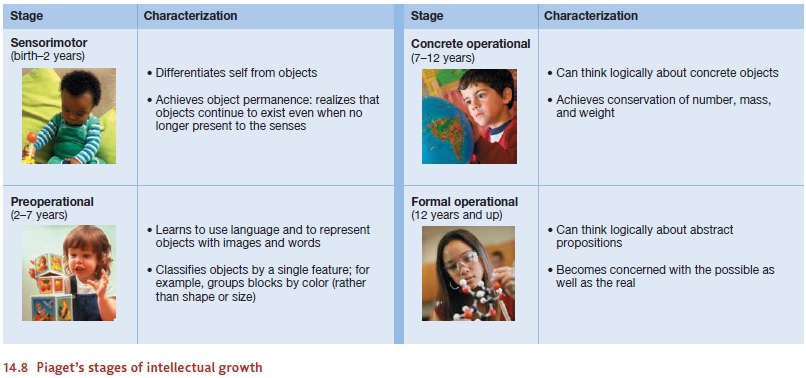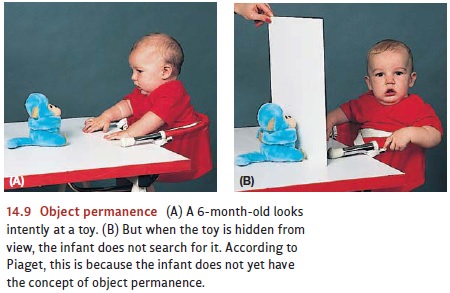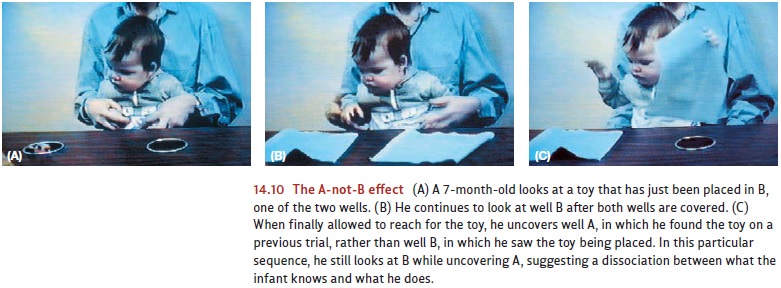Chapter: Psychology: Development
Piaget ’S Stage Theory
PIAGET
’S STAGE THEORY
According
to Piaget, the child relies on a different type
of thinking than an adult does. In Piaget’s view, adult thinking emerges only
after the child has moved through a series of stages of intellectual growth
(Figure 14.8). They are the sensorimotor
period (from birth to about 2 years), the preoperational period (roughly 2 to 7 years), the concrete operational period (7 to 12
years), and the formal operational period
(approximately 12 years and up).

During
the sensorimotor period, Piaget
argued, the infant’s world consists of his own sensations. Therefore, when an
infant looks at a rattle, he is aware of looking at the rattle but has no
conception of the rattle itself existing as a permanent, independent object. If
the infant looks away from the rattle (and thus stops seeing it), then the
rat-tle ceases to exist. It is not just “out of sight, out of mind”—it is “out
of sight, out of existence.” In this way, Piaget claimed, infants lack a sense
of object permanence—the
understanding that objects exist independent of our momentary sensory or
motoric interactions with them.
Piaget
developed this view based on his observation that infants typically look at a
new toy with delight, but if the toy disappears from view, they show little
concern (Figure 14.9). At a slightly later age, infants might show signs of
distress when the toy disappears, but they still make no effort to retrieve it.
This is true even if it seems perfectly obvious where the toy is located. For
example, an experimenter might drape a light cloth over the toy while an infant
is watching. In this situation, the toy is still easily within reach and its
shape is still (roughly) visible through the folds of the cloth. The child
watched it being covered just moments earlier. But still the infant makes no effort
to retrieve it.

At about 8 months, infants do start to search for toys that have been hidden, but even then, their searching shows a peculiar limitation. Suppose, that a 9-month-old sees an experimenter hide a toy monkey under a cover located, say, to the child’s right. The child will happily push the cover off and snatch up the monkey. The experimenter now repeats the process a few times, always hiding the monkey under the same cover to the child’s right. Again and again the child pulls the cover off and retrieves the monkey. But now the experimenter changes the procedure slightly. Very slowly and in full view of the child, she hides the toy in a different place, say, under a cover to the child’s left. The child closely watches her every movement—and then does exactly what he did before. He searches under the cover on the right, even though he saw the experimenter hide the toy in another place just a moment earlier.
This
phenomenon is often called the A-not-B
effect, where A designates the
place where the object was first hidden and B
the place where it was hidden last (Figure 14.10). Why does this peculiar error
occur? Piaget (1952) argued that the 9-month-old still has not grasped the fact
that an object’s existence is independent of his own actions. Thus, the child
believes that his reaching toward place A (where he found the toy previously)
is as much a part of the monkey as the monkey’s tail is. In effect, then, the
child is not really searching for a monkey; he is searching for
the-monkey-that-I-find-on-the-right. No wonder, there-fore, that the child
continues searching in the same place.

According
to Piaget, a major accomplishment of the sensorimotor period is coming to
understand that objects exist on their own—even when they are not reached for,
seen, heard, or felt. Piaget held that what makes this accomplishment possible
is the infant’s increasingly sophisticated schemas—ways
of interacting with the world and (at a later stage of development) ways of
interacting with ideas about the
world.
Piaget
believed that newborns start life with very few schemas, and these tend to
involve the infant’s built-in reactions, such as sucking or grasping. In
Piaget’s view, these action pat-terns provide the infant’s only means of
responding to the world, and thus they provide the first mental categories
through which infants organize their world. Infants understand the world, in
other words, as consisting of the suckables, the graspables, and so on.
Across
the first few months of life, though, the child refines and extends these
schemas and learns how to integrate them into more complex ways of dealing with
the world. This evolution, according to Piaget, depends on two processes that
he claimed were responsible for all cognitive development: assimilation and
accommodation. In the process of assimilation,
children use the mental schemas they have already formed to interpret (and act
on) the environment; in other words, they assimilate objects in the environment
into their existing schemas. In the process of accommodation, the child’s schemas change as a result of his
experiences interacting with the world; that is, the schemas accommodate to the
environment (Figure 14.11).

Through
the processes of assimilation and accommodation, the child refines and
differentiates her schemas, which gradually leads her to create a range of new
schemas that enhance her ability to interact with the world. In addition, as
the child becomes increasingly skilled at using schemas, she eventually becomes
able to use more than one schema at a time—reaching while looking, grasping
while sucking. Coordinating these individual actions into one unified
exploratory schema helps to break the connection between an object and a
specific way of acting on or experiencing that object. This liberation of the
object from a specific action, in turn, helps propel the child toward
understanding the object’s independent existence—that is, it helps propel her
toward object permanence and a mature understanding of what an object is.
Piaget
believed that the sensorimotor period ends when children achieve object
per-manence (and, thus, the capacity for representational thought) at roughly 2
years of age. But, even so, the mental world of 2-year-olds is, in Piaget’s
view, a far cry from the world of adults. This is because 2-year-olds have not
yet learned how to interrelate their
mental representations in a coherent way. Piaget referred to the manipulation
of men-tal representations as operations,
and thus dubbed the period from age 2 to 7, before these mental operations are
evident, as the preoperational period.
A
revealing example of preoperational thought is the young child’s apparent
failure to conserve quantity. One procedure demonstrating this failure uses two
identical glasses, A and B, which stand side by side and are filled with the
same amount of liq-uid. The experimenter then asks the child whether there is
more liquid in one glass or the other, then obligingly adds a drop here, a drop
there until the child is completely satisfied that there is “the same to drink
in this glass as in that.”
The
next step involves a new glass, C, which is taller but narrower than A and B
(Figure 14.12). While the child is watching, the experimenter pours the entire
contents of glass A into glass C. She then points to B and C and asks, “Is
there more in this glass or in that, or are they the same?” To an adult, the
amounts are obviously identical, since A was completely emptied into C, and A
and B were made equal at the outset. But 4- or 5-year-olds insist that there is
more liquid in C. When asked for their reason, they explain that the liquid
comes to a much higher level in C. They seem to think that the amount has
increased as it was transferred from one glass to another. They are too
impressed by the visible changes in liquid level to realize that the amount
nonetheless remains constant.

In
the preoperational period, children also fail tests that depend on the
conservation of number. In one such test, the experimenter first shows the
child two rows of pennies, and the child agrees that both rows contain the same
number of coins. The experimenter then rearranges one row by spacing the
pennies farther apart. Prior to age 5 or 6, chil-dren generally assert that
there are now more coins in this row because “they’re more spread out.” But
from about age 6 on, the child has no doubt that there are just as many coins
in the tightly spaced row as there are in the spread-out line.
Why
do preschool children fail to conserve? According to Piaget, part of the
problem is their inability to interrelate the different dimensions of a
situation. To conserve liquid quantity, for example, the children must first
comprehend that there are two relevant factors: the height of the liquid
column, and the width of the glass. They must then appreciate that a decrease
in the column’s height is accompanied by an increase in its width. Thus, the children
must be able to attend to both dimensions simultaneously and relate the
dimensions to each other. They lack this capacity, since it requires using a
higher-order schema to combine initially discrete aspects of a percep-tual
experience into one conceptual unit.
By
age 7 or so, once children have learned how to interrelate their mental
represen-tations, they enter the concrete
operational period. They now grasp the fact that changes in one aspect of a
situation can be compensated for by changes in some other aspect. They are also
able to transform their own mental representations in a variety of ways and
thus understand, for example, what would happen if the liquid were poured back
into its original glass. But according to Piaget, children’s intellectual
capacities are still limited in an important way: They can apply their mental
operations only to con-crete objects or events (hence the term concrete operations). It is not until
age 11 or 12 that formal operations are possible, and we will consider this
stage in the following sec-tion on adolescence.
Related Topics